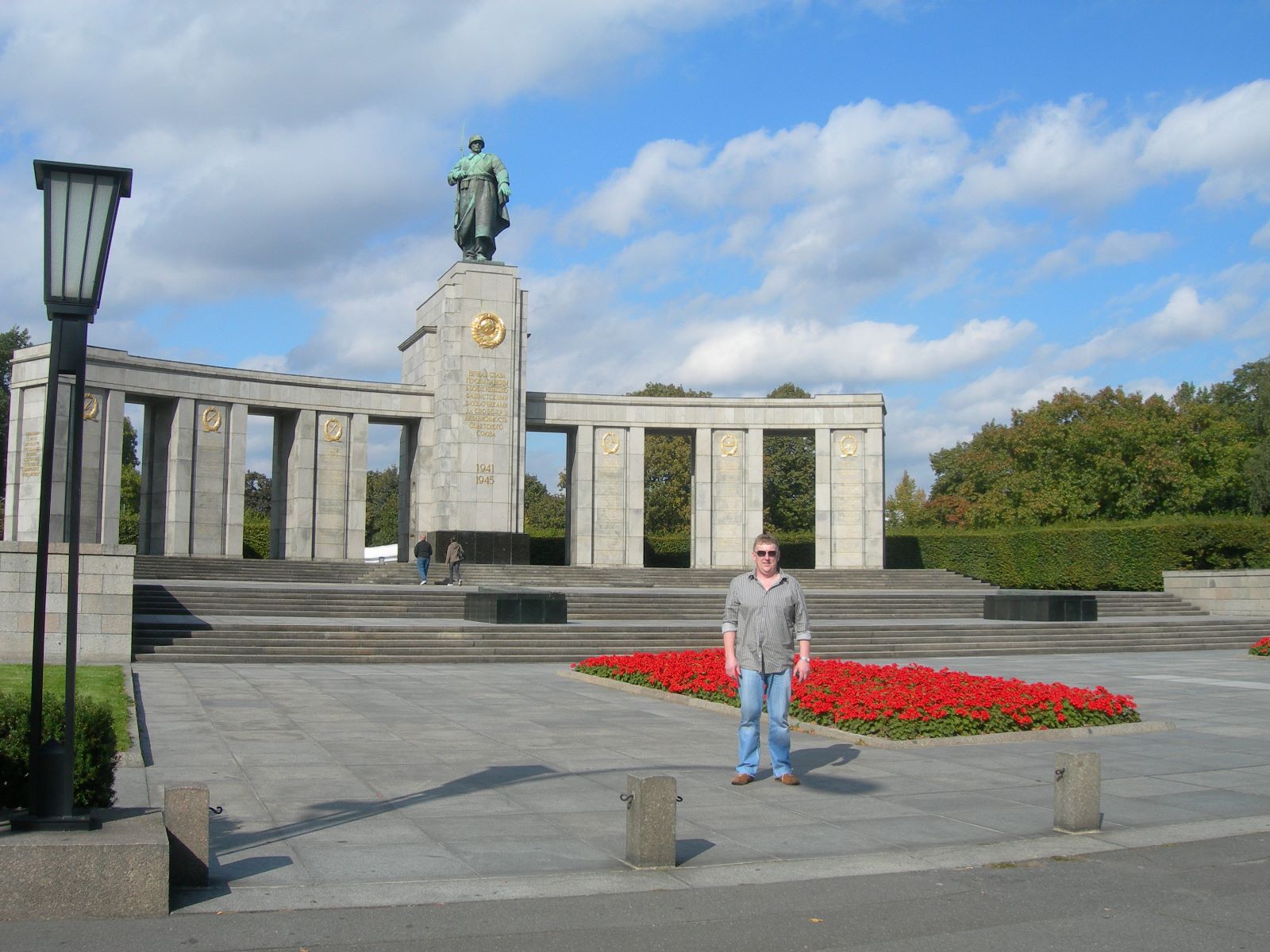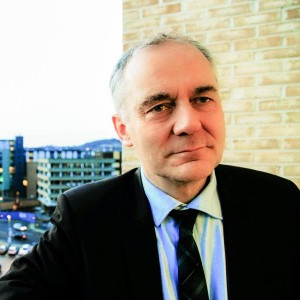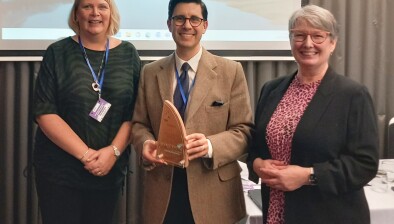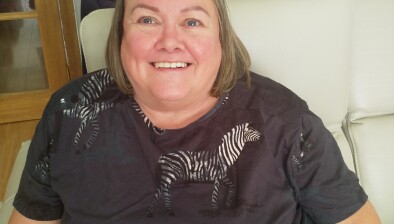Housing Champion: Calum (Barney) MacKay
Barney in An Lanntair, Stornoway’s arts centre cafe
Jimmy Black cycled to Stornoway to meet Calum (Barney) MacKay, chair of TPAS Scotland and long-standing tenant activist.
Barney is a trade unionist, and that explains a lot. Trades unions teach their active members how to do many useful things, including basic skills, like how to run a meeting or the more advanced techniques involved in negotiation.
Back in the 1980s, when tenants on the windswept Cearns housing scheme decided to do something about their damp, poorly maintained and badly managed homes, Barney had plenty of trades union experience to bring to the table.
Working on the bins on the Isle of Lewis, Barney and his colleagues were aware that they were underpaid, and their working conditions were less than ideal. “We weren’t classed as anything special and we had to turn that round.” So he was part of the union, in those days the TGWU, and campaigned for the respect they were due.
At this point Maggie Thatcher took a hand and imposed compulsory competitive tendering (CCT) on council services. The Western Isles Islands Council made the odd decision to split the cleansing services up by islands, and the decision went through on the nod. It took the unions … ie Barney and his colleagues … to point out to the councillors that private companies would cherry-pick the more profitable bits and the council would be left with the more difficult and costly services, splitting the workforce in half.

Barney in his younger days
Some of the councillors at least, simply hadn’t read or understood the thick report they waved through. A meeting of the cleansing service workforce took place, and they requested that Barney meet with the leader of the council. The council was recalled, the decision was overturned, and Barney found himself elected as branch secretary for the Western Isles.
Later, Barney was at the heart of negotiating equal pay for equal work when the Western Isles was getting to grips with Single Status, which has been a costly problem for bigger councils like Glasgow and Dundee. “Care workers, cleaners, bin men, dinner ladies … each one of these groups got salary increases and back pay. I was quite pleased with that, it was a fair policy for these people who work hard. With a lot of meetings, a lot of negotiations, we got there.”
Meetings, negotiation and compromise were Barney’s tools. “I wasn’t confrontational. Pointing things out to the councillors was more helpful.” The council created a full time trade union position, which Barney filled.
That brings us back to the Cearns estate, where Barney lived in a council house. Described in a PhD thesis as “reminiscent of a mainland urban scheme”*, Cearns sits on the steep slopes above Laxdale, wide open to the wind and rain. The houses are tightly packed into a small site. On a clear day, the views are spectacular. The first 34 houses were built in 1975 at Cearnan Hiort and also Cearnan Shodhaidh, and by 1982 there were 255. But the scheme got off to a bad start.
Barney told me, “The Cearns scheme was that derelict, with no amenities, and it got the horrible name of Colditz. Big high black fences, no environmental maintenance, barely wind and watertight houses. It wasn’t managed right, the council built up a huge debt on the housing revenue account, and there was some ignorance. Someone said that the tenants should be happy to have a house and they should stop their moaning.”
Jimmy’s transport at the Cearns signboard with one of Lewis’ ‘brutalist’ bus shelters in the background
“Cearns was built on ‘the grip’, that means they were built fast,” says Barney. “The chimneys were belting out smoke everywhere. The cavities in the walls were filled with broken bricks and tiles.”
So a group of tenants went round taking photographs of the problems in the homes, showing the dampness and disrepair in a relatively new scheme. They banded together with others, including fellow trades unionist George Lonie, to get things moving, and they set up a tenants group in 1983.
They took their case to the councillors, met housing management, set forth their ideas, and gained credibility with the decision-makers.
“It took time for the councillors and officials to respect you,” says Barney, “and at first they were looking down on you, thinking ‘what’s he got to say?’, but that soon changed when we put a concise argument to them.”
As an example, the association told the councillors that the council policy of replacing windows with Norwegian wooden frames was twice as dear as buying low maintenance pvc frames, made locally. If they went for pvc they could upgrade twice as many houses for the budget. They won their point.
The Cearns houses were tightly packed, more like an urban scheme
They campaigned for a handyman to keep the scheme tidy, for playparks for the kids, shop units and community facilities. Eventually, the association was given a non voting seat on the housing committee and Barney was their chosen representative.
As time went on and some people bought their houses, the group morphed into a residents group, and then a community association. “I was opposed to the right to buy, but people would have to be idiotic not to take up the opportunity. It was very important to have the whole community involved in the group because things like grass cutting, paths and the police concern everyone.” Tenants’ groups elsewhere in Scotland were not always so inclusive.
Big issues were waiting round the corner. Stock transfer gave the council the opportunity to get rid of its huge housing debt and hand over the houses to a registered social landlord. “Initially I was sceptical, let’s call it that, about taking the stock out of council hands. I thought it sounded political.
“But TPAS came in as advisers, and I looked into it, and the main selling points were that the council hadn’t been building for a number of years, there was a huge waiting list and very little turnaround of houses. The transfer guarantee would mean more new build, a five-year rent guarantee and an improved investment programme, and staff would be transferred over. These guarantees have been kept and surpassed.”
Barney, who in 2004 was chairman of the Western Isles Residents Forum, found himself on the shadow board to implement transfer, and in 2005, 69% of council tenants voted Yes. Since then Hebridean Housing Partnership (HHP) has built over 600 new homes, and the development and investment programme continues.
Cearns from Laxdale Road
At the same time, he was dealing with the same issues at national level, sitting on the board of TPAS, the Tenant Participation Advisory Service. He had been involved for some years. How did he get onto the TPAS board?
“I was nominated by the Cearns Association. I went to a TPAS AGM, and asked a question! That’s how I got elected to the board. One of the big issues we discussed was budgets for tenant participation. The budgets were there, but housing associations and councils were not spending them as they should. We’d tell people, go to conferences, have meetings, that’s what the tenant participation budget is there for. If you don’t use it the money goes back into the central coffers.”
Barney worked with notable characters such as Marjorie Bain, then working in Shetland, Lesley Baird and Elaine Scoular, to push the agenda forward. Campaigns by TPAS and others led to the Housing (Scotland) Act 2001 which created a legal requirement for landlords to actively develop and support tenant participation. TPAS was heavily involved in providing independent advice to tenants whose landlords were considering stock transfers, and as a board member, Barney was able to contribute his local experience to the national debate.
Creating a legal right does not in itself ensure that tenant participation actually happens. Barney has concerns that the traditional model of tenant participation is losing ground and as chair of TPAS he is keen to make participation more accessible.
Distance and disability can be major factors in preventing people from getting involved, and TPAS’ business plan reflects that understanding.
Community facilities in Cearns
“We’re in the midst of moving in a new direction, getting tenants involved in a different way using technology. You can set up a group in an outlying area and use Teams or Zoom, and argue for tenant participation money to get the laptops to do that. In the Hebridean Housing Partnership (HHP) we have Teams, people from Ness and Harris and further out who would have a long drive home can now log on in their spare rooms.
“TPAS is Scotland wide and we still need to have some face-to-face meetings, but the majority will be on Teams.”
Life took a difficult turn in 2018 when Barney developed vasculitis. It took some time to get a diagnosis and he was no longer physically able to work in his old job for the union. Technology made it possible for Barney to continue his voluntary roles with HHP, TPAS and the Cearns Community Association.
The illness was debilitating, and Barney had to learn to walk again, and is still building up his strength. He recognises how important being able to continue participating in TPAS has been for his own personal welfare. “TPAS kept things open for me when I was not so fit as I am now. I was able to take part from my spare room, and it kept my brain going.”
Barney is a man of many boards, committees and community groups. He’s held many positions … union branch officer, chair of TPAS, and vice chair at HHP. What makes him do it?

Barney representing TPAS at the International Union of Tenants in Berlin, in 2007
“It’s better fighting from the inside. If you’re inside you can do something, if you’re outside you can shout as loud as you like but it’s not going to make any difference. I read the reports, I probably ask too many questions, I never let things go by. I look at the purpose of a proposal, the financial outcomes, the problems, the recommendations. That’s what’s important.”
His involvement in so many areas which are key to daily life mean that people are always asking him questions, about housing, the bins, pensions and much else, but he’s happy that they do as it keeps him in touch with local issues.
The latest concern in the Cearns which was raised through the community association is the replacement of infrared panel heaters with more expensive air source heat pumps and the insulation which goes with them. Tenants are frustrated with delays and Barney has to explain that all the elements have to be in place before the programme can go ahead. This is just the latest local example of effective tenant participation, where good communication between landlord and tenant really works well.
He’s vice chair of HHP now, and is no longer a social housing tenant. I wondered if that had changed the way he thinks about tenant participation. As anyone who knows Barney will tell you, of course it hasn’t.
“Tenants should participate because it’s their home, and it’s important they take part in the community they live in. If you owned your house yourself you’d look after it, but the landlord owns it, so don’t wait for them to come knocking on your door. You go and knock on their door and tell them what you want. Get in there, into a registered tenants organisation or a village voice, don’t sit back and just take it.”










